 John Magill – Ellington Field Cadet PreFlight School Graduation Photo
John Magill – Ellington Field Cadet PreFlight School Graduation Photo
WWII – U.S. Army Air Corps Jan 23, 1942 through 1945: First Lieutenant
John was born in Whitinsville, Massachusetts on January 8, 1921. One Sunday in December, 1941 John was lying on the floor at home listening to the radio like he quite often did. The radio program was interrupted with news of the attack on Pearl Harbor. For John, like many young men, this tragic event was the driving force behind him joining the military.
John eagerly enlisted in the US Army Air Corps (USAAC) in January 1942 and was transferred to Fort Devens Massachusetts for processing as a new recruit. He was soon on his way to Barksdale Field in Shreveport, Louisiana where he took his first cadet exam. Next was Basic Training at the West Coast Training Center at the Santa Ana Army Air Base in California. However, during his physical exam, it was discovered that his left arm which had been broken some eighteen months prior while playing semi-pro basketball in Massachusetts wasn’t properly healed. John said his arm “moved in directions it shouldn’t”. Because of this, he was “washed out” and sent to the basic training center at Jefferson Barracks, Missouri until further notice.
John was stationed at Jefferson Barracks for about a month. He underwent a minor surgery to remove a pin or “gold wire” that had been used to hold his fractured ulna in place but was now starting to poke through the skin. Because he had to be “put under”, he was put on medical leave for ten days after the surgery. John recalled that, although this setback was frustrating, he would later learn that a large percentage of the airmen involved in the initial phases of the US Air War in Europe became casualties. He said that his injury may have very well saved his life.
After his leave, John returned to base and was pleasantly surprised when he was told to leave his bags packed and board a bus which was already loaded with other recruits and ready to leave right away. He soon arrived in Chicago, Illinois. All of the “GIs” stayed at The Stevens Hotel on Michigan Avenue which was the largest hotel in the world at the time.
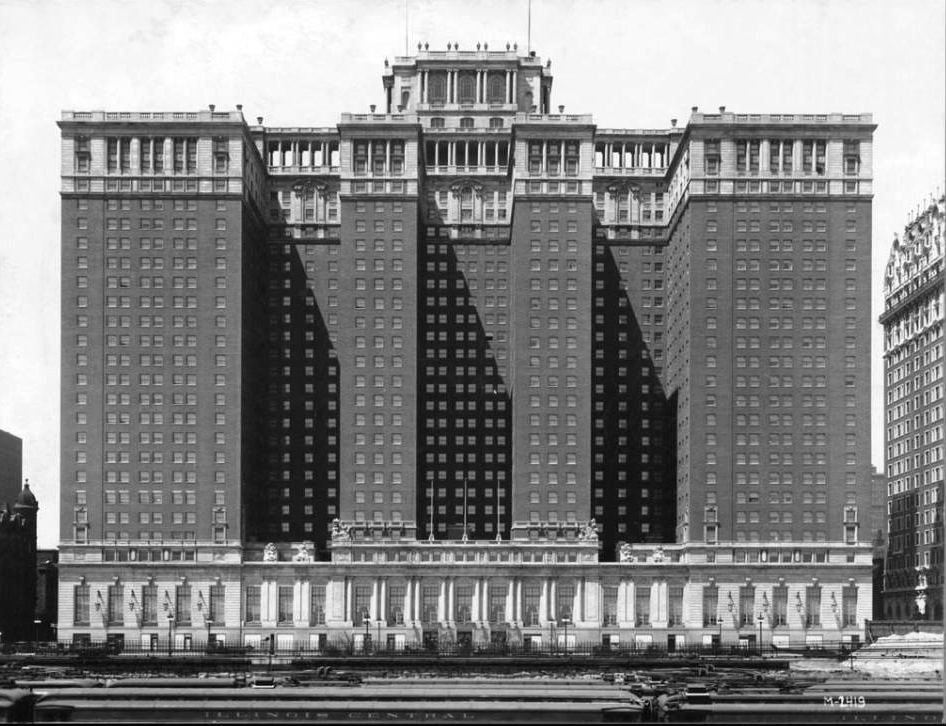 The Stevens hotel – 1927. The U.S. Army had purchased this hotel complete with furnishings for $6,000,000. It was used as the Headquarters for the Army Air Force Technical Training Center (AAFTTC) of Chicago.
The Stevens hotel – 1927. The U.S. Army had purchased this hotel complete with furnishings for $6,000,000. It was used as the Headquarters for the Army Air Force Technical Training Center (AAFTTC) of Chicago.
John said that other than the guest rooms being converted to house soldiers with the addition of bunks, the hotel was in its original state and the amenities were great. He specifically recalled the huge chandeliers in the mess hall.
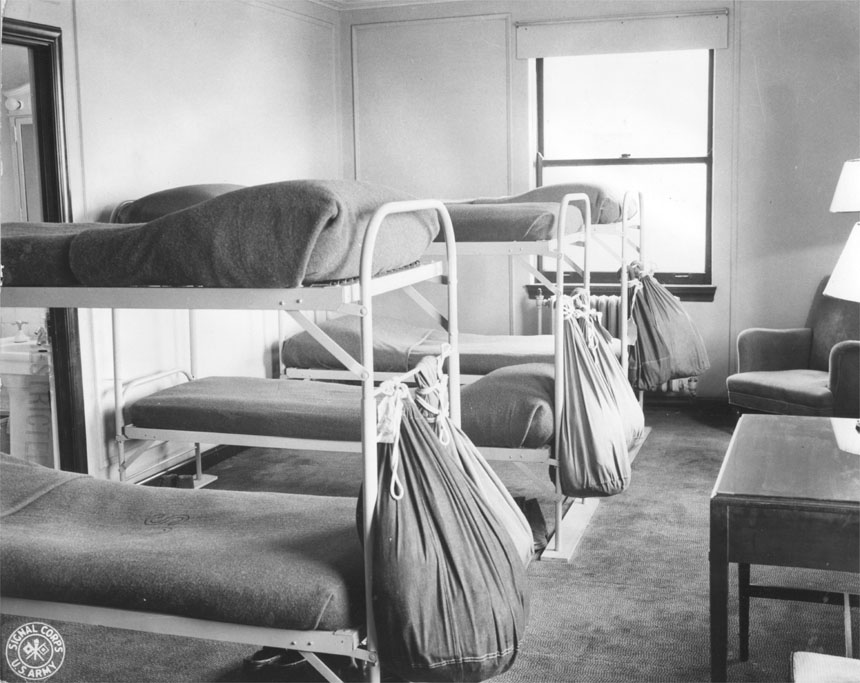 Typical six-man room in Unit No. 1 after conversion by Headquarters Chicago Schools AAFTTC.
Typical six-man room in Unit No. 1 after conversion by Headquarters Chicago Schools AAFTTC.
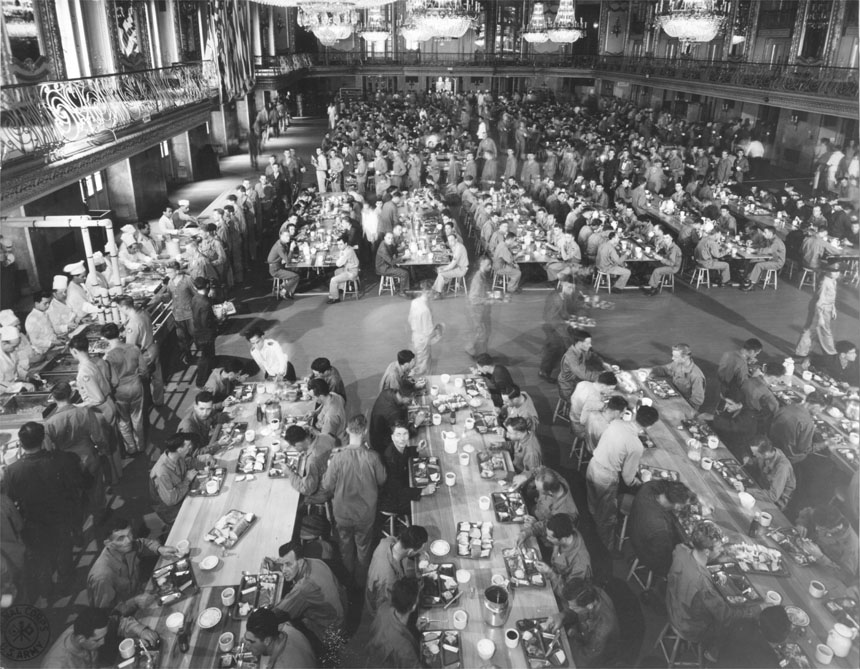 Grand Ballroom of the Stevens Hotel used as a Mess Hall
Grand Ballroom of the Stevens Hotel used as a Mess Hall
The hotel overlooked beautiful Grant Park where they would all do their physical training (PT).
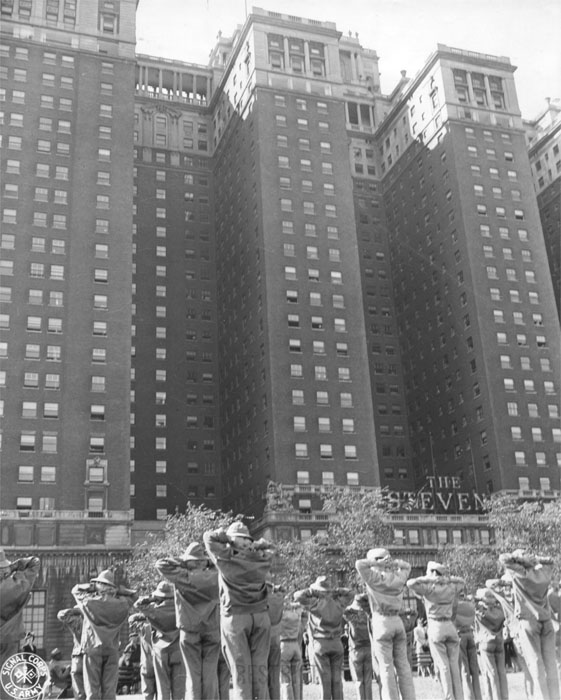 Calisthenics in Grant Park, opposite Unit #1 Stevens Hotel
Calisthenics in Grant Park, opposite Unit #1 Stevens Hotel
The AAFTTC was located just a few blocks from the hotel. This is where John attended Aircraft Mechanics classes for about three and a half months.
 Classroom Building “The Coliseum” Headquarters Chicago Schools – AAFTTC: 14 Code Rooms, 2 Radio Net Rooms, 2 Telegraphic Procedure Rooms, 2 Lecture Rooms and 3 Instructor Training Rooms.
Classroom Building “The Coliseum” Headquarters Chicago Schools – AAFTTC: 14 Code Rooms, 2 Radio Net Rooms, 2 Telegraphic Procedure Rooms, 2 Lecture Rooms and 3 Instructor Training Rooms.
During his last two weeks of instruction, he was able to witness the building of the British Merlin engines at the Packard Motor Car Company in Detroit Michigan. Rolls-Royce developed the legendary Merlin engine that held land, aviation and water speed records. It was unmatched but the Rolls Royce factories were threatened during WWII and the company needed a partner in a safe country that could produce the engines as well. They also had to be able to produce them up to Rolls-Royce standards. Packard was the one.
 Merlin engine production at Packard Motor Car Company in Detroit Michigan.
Merlin engine production at Packard Motor Car Company in Detroit Michigan.
These engines became the reliable work horses of the North American P-51 Mustang. John recalled that there was great attention to detail in every aspect of the manufacturing process. He said that during the the final inspection they would “polish the cylinders with toilet paper”.
John’s training continued at the Baltimore International Airport where he was assigned to the “flight line”. His duties included refueling planes. After two to three months, he was transferred to the San Antonio Aviation Cadet Classification Center, now the Lackland Air Force Base, where he was assigned to the dreaded KP duty. John claims that they were just finding things to keep everyone busy until they moved on to the next phase. Luckily, a friend of John’s was eventually able to get him transferred to a unit that delivered groceries to the various base kitchens. He said that it was much better than KP duty because he only worked three hours a day and didn’t have to wash dishes.
John’s journey continued at the Mississippi State College preflight school which is now the Mississippi State University. This is where he had his first flight experience. He spent three or four months flying small planes with an instructor.
 John Magill – Mississippi State College 1943
John Magill – Mississippi State College 1943
While in Mississippi John mentioned that he had the opportunity to watch a few plays. He noted that the black patrons were required to sit in the balconies and only whites could sit in the more desirable floor section. During one of the plays, a boy in the balconies was apparently really enjoying the play and laughing a lot. At some point, a frustrated man sitting in the floor section yelled, “shut up nigger!” John said that this was the first time he witnessed discrimination first hand.
John’s preflight bombardier training started at the Ellington Field cadet reception center in Houston Texas. During this ten week course, he attended classes to learn the skills necessary to accurately drop bombs on enemy targets. He also participated in hands-on training over the Gulf of Mexico. Bombardier students flew in Beechcraft AT-10s and AT-11s and practiced bombing several small islands in Matagorda Bay and small target boats anchored in the bay. John said the “bombs” were 100lb bags of sand.
 Beechcraft AT-10 Wichita, 1943
Beechcraft AT-10 Wichita, 1943
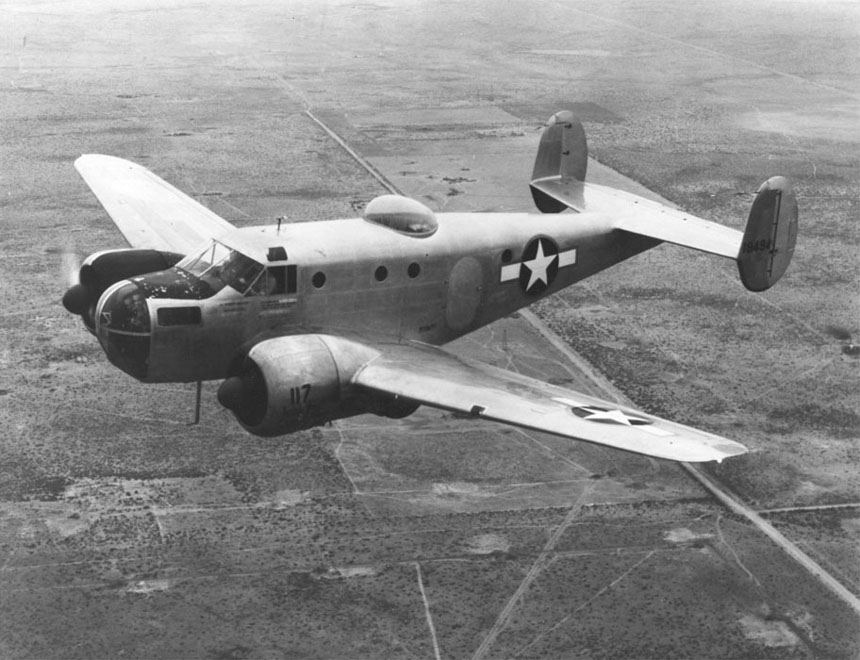 Beechcraft AT-11 West Texas 1944
Beechcraft AT-11 West Texas 1944
John then received advanced bombardier training at the Childress Army Airfield in Texas . Upon graduating with class 44-10, he was transferred to an operational training unit at the Drew Army Airfield in Tampa, FL which is now the Tampa International Airport. John was assigned to a crew headed by pilot Benton (Ben) Gatch. He trained with this crew for three months in preparation for deployment to Europe. However, when the time came, he was informed that they already had enough bombardiers in the field and that he would remain in Florida until further notice. Meanwhile, the other members of the Gatch crew headed to England. In a true testament to the patriotism of the day, John recalled being frustrated and concerned that the war would be over before he had a chance to contribute. He was soon assigned to a new crew headed by pilot Arnold Morton Singer. After an additional three months of training, the Singer crew was finally given the green light to head to England.
In late 1944 – early 1945, the crew, along with many others, headed to Hunter Army Airfield in Savannah, GA to pick up their planes. John said that these planes were put into a huge pool for distribution to various units upon arrival in England. After a short stop in Manchester, NH, they arrived at the Royal Canadian Air Force (RCAF) Station in Gander, Newfoundland which was the gateway through which thousands of aircraft flown by the United States Army Air Corps and the RCAF destined for the European Theater traveled.
After a two week wait for improved weather, they finally headed out over the North Atlantic late one night at 11PM. John said that, despite all precautions, they ran into a terrible blizzard that would have certainly killed them all if not for the skill of their pilot. John described this event as though it was happening in real time. He recited, in great detail, the multitude of technical measurements he recorded (airspeed etc.) and the corresponding actions taken by the pilot to maintain control of the aircraft.
Having narrowly averted disaster, they arrived at an airbase in Keflavik, Iceland for a short stop over and then headed on to Royal Airforce (RAF) Heathfield in Ayr, Scotland. They remained in Scotland for two days before taking a train to Royal Air Force (RAF) Framlingham, Suffolk, England. Here they were assigned to the 570th Bombardment Squadron Heavy (H), 390th Bombardment Group (BG), US 8th AF located at airfield station 153. John said that all of their missions were flown from this location.
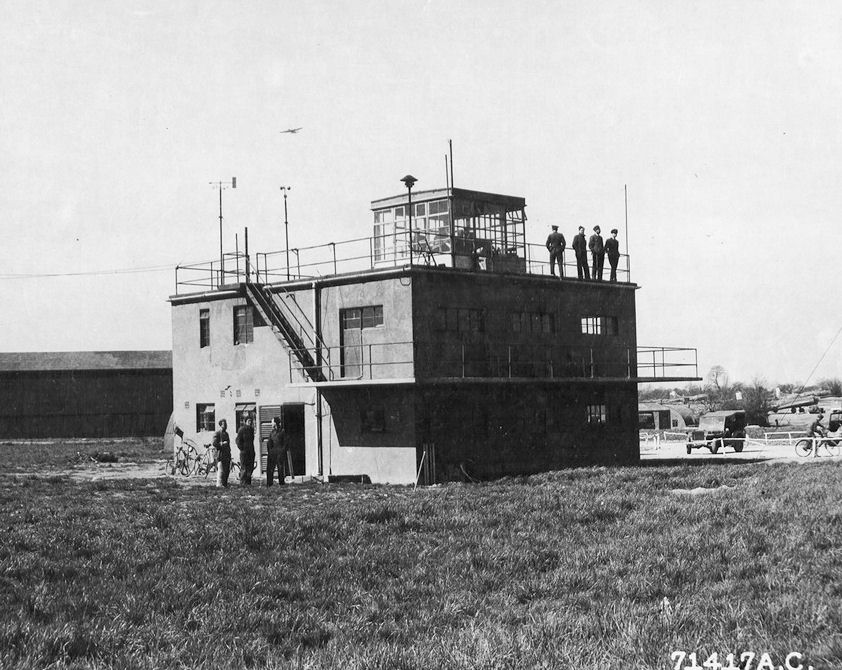
RAF Framlingham Station 153 Control Tower – May 22, 1944. The 390th Bombardment Group Memorial Air Museum is housed in this original, wartime building. John said that he once visited this museum.
The crew practiced formation flying from January through February, 1945 in preparation for their first mission. John said that this training was extremely important as the best defense against the Germans was a tight formation in which the B-17 gunners could best protect each other from the German fighters. They had been told that the German fighter pilots would specifically target the loose formations. In addition, proper formations allowed the B-17s to properly concentrate the release of their bombs on a given target.

RAF Framlingham Headquarters Buildings – March 1945. John was stationed at this airfield when this photo was taken.
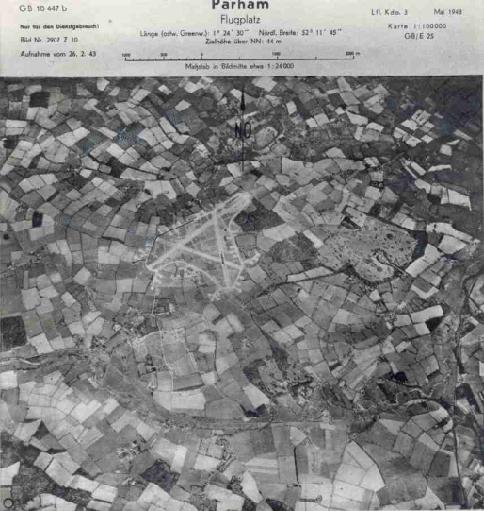
RAF Framlingham as seen from a German reconnaissance plane – March 1943.
Sometime after his arrival in England, John inquired about his original, Ben Gatch, crew. He was informed that they had all been killed in action. It wasn’t until after the war that John learned the full details of his original crew’s ill-fated mission. On March 2, 1945, Gatch’s crew, as part of the 339th Bombing Squadron of the 96th Bombing Group, took off from Royal Airforce (RAF) Snetterton Heath, England for a mission over Dresden, Germany. Shortly after take-off, Gatch’s B-17 (43-37767) had a mid-air collision over the North Sea with Herb Stillwell’s B-17 (44-8697) which was part of the 413th Bombing Squadron flying in the same formation. According to the official Missing Air Crew Report (MACR) 12848, Stillwell’s plane made a sudden upward adjustment striking Gatch’s plane from below near the ball turret, which is the weakest point on a B-17 bomber, causing Gatch’s plane to split in two and plunged into the ocean. Both B-17s were ditched at sea approximately 10 miles south of Southwold, Suffolk, England. All crew members aboard both planes were killed. John said that, much like his basketball injury delayed his early entry into the war, avoiding the heavy casualty rate of airmen, the abundance of bombardiers which forced him to change crews was yet another blessing in disguise that resulted in his life being spared. There’s a very strong possibility that he would have been on board Gatch’s plane during that ill-fated mission had he not been reassigned to Singer’s crew in Florida.
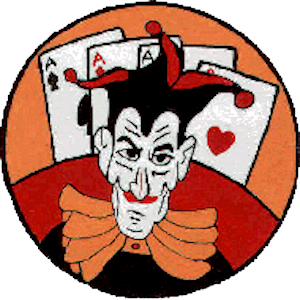 Emblem of the 570th Bombardment Squadron
Emblem of the 570th Bombardment Squadron
The 390th Bombardment Group (Heavy) began arriving at Framlingham on July 4, 1943 from Great Falls Army Air Base Montana. The 390th was assigned to the 13th Combat Bombardment Wing and the group tail code was a “Square-J”. A total of 300 mission were flown by the 390th during WWII. The 570th Bombardment Squadron (Heavy) used the code “DI” on the fuselage (body) of their planes.
John’s Missions During WWII
| Crew Number | Aircraft Serial Number [Crew 62] |
Aircraft Name | A/C | Mission Number [390th] |
Target | Date |
| 62 | (11Dec44) 339041 | She Dood It | U | 270 [275] | Oranienburg Germany[1] | 3/15/1945 |
| 62 | (11Dec44) 339041 | She Dood It | U | 271 [276] | Ruhland Germany | 3/17/1945 |
| 62 | (11Dec44) 339041 | She Dood It | U | 274 [279] | Handorf Germany | 3/21/1945 |
| 62 | (8Aug44) 338196 | Satan’s Second Sister | A | 275 [280] | Ahlhorn-Oldenburg Germany | 3/22/1945 |
| 62 | (8Aug44) 338196 | Satan’s Second Sister | A | 276 [281] | Schwerte-Holzeickede Germany | 3/23/1945 |
| 62 | (11Dec44) 339041 | She Dood It | U | 280 [286] | Zeitz Germany | 3/31/1945 |
| PPP | (8Aug44) 338196 [46607] |
Satan’s Second Sister | A | 282 [288] | Kiel Germany | 4/4/1945 |
| PPP | (10Oct44) 46607 [231728] |
E | 283 [289] | Nürnberg Germany | 4/5/1945 | |
| 62 | (11Jan44) 231728 | Sweetheart of Pas de Calais | B | 284 [290] | Leipzig Germany | 4/6/1945 |
| 62 | (11Jan44) 231728 | Sweetheart of Pas de Calais | B | 285 [291] | Neumünster Germany | 4/7/1945 |
| 62 | (11Jan44) 231728 | Sweetheart of Pas de Calais | B | 286 [292] | Eger Germany (Egerland CZ) | 4/8/1945 |
| PPP | (10Sep44) 48169 [337836] |
Q | 288 [294] | Magdeburg (Burg) Germany | 4/10/1945 | |
| 53 | (11Sep44) 338478 [231728] |
Hotter ‘N Hell | S | 289 [295] | Landshut Germany* | 4/11/1945 |
| 62 | (11Jan44) 231728 | Sweetheart of Pas de Calais | B | 290 [296] | Royan France* | 4/14/1945 |
| 62 | (17Jun44) 337836 | Merry Max | J | 291 [297] | Royan France | 4/15/1945 |
| 71 | (18Jan45) 339024 [239927] |
Lady Faithful/They’ve Had It | X | 298 | Royan France | 4/16/1945 |
| 72 | (18Jan45) 339024 | Lady Faithful/They’ve Had It | X | 295 [CH1] | Valkenburg / Haarlem Holland | 5/1/1945 |
| 70 | (18Jan45) 339024 [46097] |
Lady Faithful/They’ve Had It | X | 296 [CH2] | Amsterdam Holland | 5/2/1945 |
| 62 | (22May44) 46097 | Cocaine Bill | D | 300 [CH6] | Vogelenzang Holland | 5/7/1945 |
Dates above serial numbers indicate when the aircraft was delivered to the 8th Air Force in England. All of the aircraft listed above returned to the US after the war except for Satan’s Second Sister (338196 A). See collision photo below. 1Oranienburg became the center of Nazi Germany’s nuclear-energy project. According to military historian Antony Beevor, Stalin’s desire to acquire that facility motivated him to launch the Battle for Berlin of April-May 1945. It is speculated that the pre-emptive destruction of these facilities by the USAAF Eighth Air Force on 15 March 1945 aimed to prevent them from falling into Soviet hands. * No opposition encountered – “Milk Run”.
Between March 15 and May 7, 1945, John participated in 19 missions: 13 over Germany, 3 over France and 3 over Holland (Operation Chowhound). John’s primary crew #62 (Singer) participated in all but two of these missions (CH1 & CH2), and he was with that crew for 12 of them. John said that it was a miracle that no one in this crew was ever injured.
Although the outcome of each mission was an unknown, there were several events that played out like clockwork. After they took off but before they reached 10,000 feet, John would climb up through a door near the co-pilot’s feet and make his way towards the front of the bombs. At the same time, one of the waist gunners would make his way to the rear. To arm the bombs, both men would remove the pins that were located at each end and safely stow them in their pockets. Although it never happened on one of John’s missions, he mentioned that there were occasions when this procedure was forgotten and unarmed bombs were dropped. In the unlikely event that a mission was aborted, the pins would be replaced to disarm the bombs.
As the bomber approached 10,000 feet, all of the crew would put on their oxygen masks. It was John’s responsibility to announce an “oxygen check” over the plane’s intercom every ten minutes. He said that loss of oxygen was a very real danger. A hose could easily be kinked or completely disconnected without an airman noticing. John recalled from his training in altitude chambers that an oxygen deprived individual feels as though everything is perfectly fine even though his judgement is completely impaired. This could easily lead to irrational behavior and unconsciousness.
After dropping their bombs, the squadron would descend to about 2,000 feet so they could regroup for the flight back to England. Probably as a sigh of relief that the mission’s objective had been accomplished and in hopes of a safe return, John said that his navigator, John Hoffman, would sing a song about his girlfriend back home. Almost as if he were reliving that moment, John started singing “I’m coming home Miss Margaret!” With a smile, he said that his navigator was a big tall guy and that he would sing that song with a squeaky, high-pitched voice.
Germany
By 1944 – 1945, the Luftwaffe’s air superiority had come to an end due to a combination of the Allies’ superior numbers and improved tactics and Germany’s ever-dwindling supply of trained pilots and aviation fuel. Because of this, John only encountered German fighters on two of his missions. However, he said that flak[1] from the German anti-aircraft guns was ever-present and very heavy, intensifying near key bombing targets like oil refineries. Only two of John’s missions were “milk runs” as they encountered no opposition at all.
1derived from the German word Fliegerabwehrkanone which means “aircraft defence cannon”
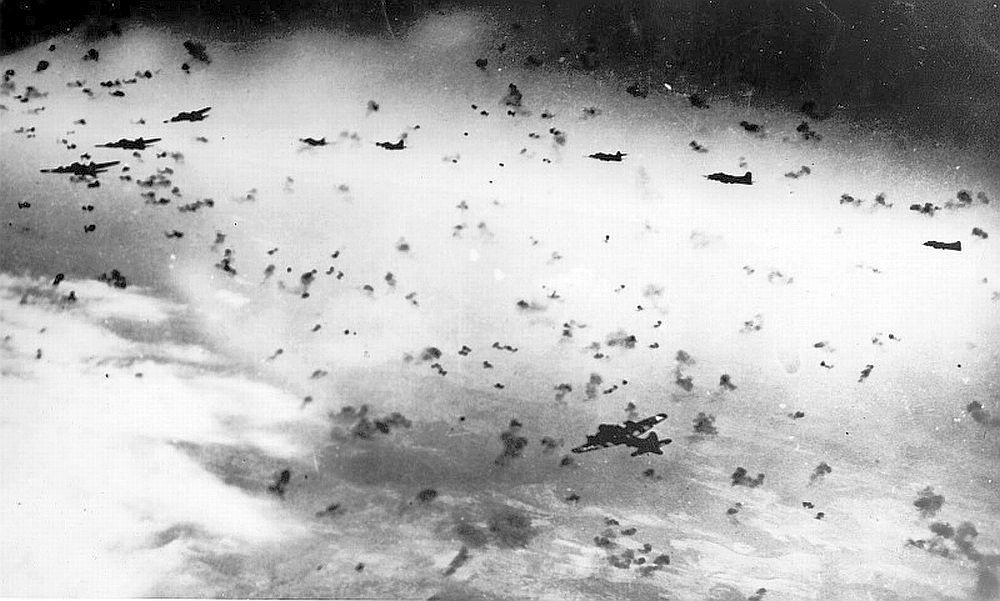
Example of “flak” during B-17 Mission
There was so much flak that John could “smell the cordite” from the exploding shells and the plane would violently shake and shudder. The flak would “rip through the aluminum body like it was butter” and the plane would quite often look like “Swiss cheese” when they returned from a mission.
John recalled that after one mission, there was a basketball sized hole on the side of the plane near his Navigator, Joseph (Joe) Hoffman. Luckily it had only penetrated the outer layer of metal otherwise Joe would have been severely injured or killed.
On another occasion, the Ball Turret took a hit which damaged the door that leads to the plane, preventing the operator, Samuel Robertson, from getting out prior to landing. John said that Samuel didn’t even remember returning to Framlingham. John speculated that he was either knocked unconscious or in a state of shock. If just one of the tires on the plane had been damaged, the ball turret would have been crushed on landing.
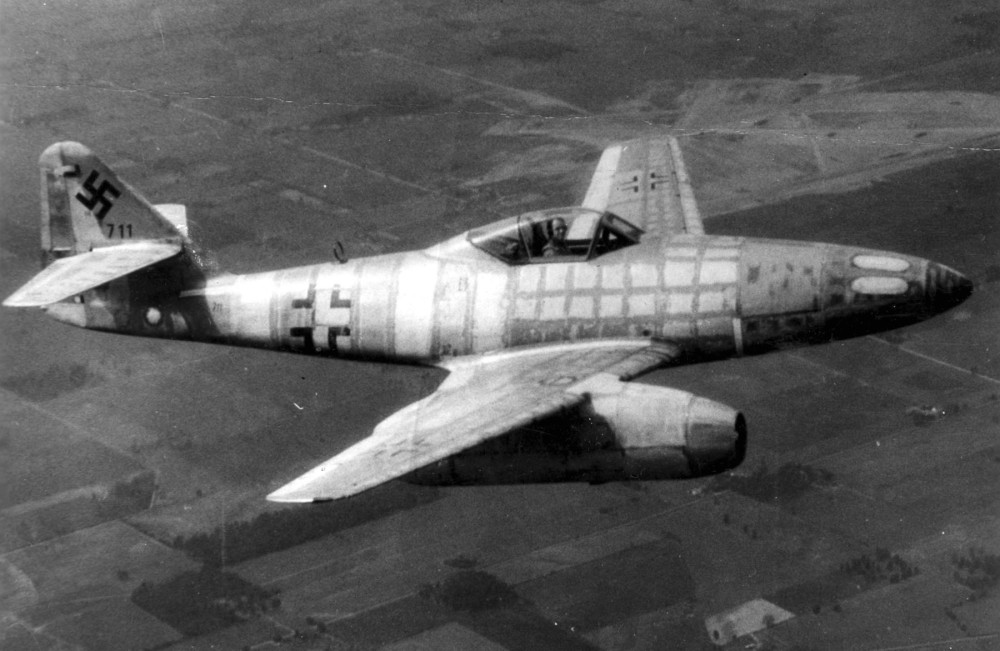
This airframe, Wrknr. 111711, was the first ME-262 to come into Allied hands when its test pilot defected in March 1945. It was subsequently lost in August 1946, the US test pilot parachuting to safety.
On two occasions, John mentioned seeing the infamous Messerschmidt 262 (ME-262). Because of the ME-262’s tremendous speed, he would say “What was that!”, and then soon realize what it was. John said that they would swoop down, attack from the rear and then fly right past him at the nose of the bomber. Each time the Tail Gunner did a great job keeping them off their plane. John mentioned that, although he had control of the two .50 caliber guns mounted under the “chin” of the B-17, he never had an opportunity to fire at the fighters as they were just too fast.
 Excerpt from pilot Arnold Singer’s Flight Log showing the encounter with an ME-262 during the Neumünster Germany mission on April 7, 1945.
Excerpt from pilot Arnold Singer’s Flight Log showing the encounter with an ME-262 during the Neumünster Germany mission on April 7, 1945.
During each of these encounters, the ME-262 disengaged their plane then swooped behind and shot the B-17 next to them causing it to burst into flames. One of these incidents occurred during the April 7, 1945 mission over Neumünster Germany. The ME-262 shot down the William Kotta crew flying Hard To Get 48225 J(L). Luckily all nine crew members were able to bail out and became POWs rather than KIAs as the plane crashed in Celle, Germany (MACR 13891). John said that crews were accustomed to calling out “count chutes!” whenever they saw a plane go down. This type of information would be relayed during their debriefing once they returned to base.
France
John participated in three missions over France. In the first mission he was part of a group of 1,167 bombers that were dispatched to attack enemy pockets on the French Gironde estuary. The air attacks precede a ground assault by a French detachment of the Sixth Army Group on the German defense pockets which denied the Allies use of port facilities in the Bordeaux area. John said that this mission was a “milk run” with no German opposition at all.
 Excerpt from pilot Arnold Singer’s Flight Log showing the Royan France missions. Note the mention of “no opposition” on the first mission (milk run) and “oil bombs” on the second.
Excerpt from pilot Arnold Singer’s Flight Log showing the Royan France missions. Note the mention of “no opposition” on the first mission (milk run) and “oil bombs” on the second.
On his second mission, John was part of a group of 492 B-17s and 341 B-24s that attacked strong points on the French Atlantic coast. He said that they were carrying bombs loaded with “jelly gasoline mixtures” and that the smell of petroleum inside the plane was overwhelming. It was later learned that this was an extensive and pioneering use of napalm. These two groups of planes made the sole operational employment of napalm by the 8th AF against German ground installations (pillboxes, gun pits, tank trenches, and heavy gun emplacements). The results were deemed negligible and headquarters recommended its discontinuance against these types of targets.
In his final mission over France, John was part of a group of 485 B-17s. They bombed the German tank ditch defense line at Pointe de Grave on the South side of the Gironde estuary in the Bordeaux area in support of the Allied ground assault in that region.
Prior to returning from this mission, John’s crew was given permission to do a flyover “buzz” of London on the way back to Framlingham in a show of celebration that the end of the war was in sight. He said that several planes went into a tight formation as they neared the city. Suddenly the plane below John’s sharply went up and down several times narrowly missing their plane. Each time the pilot of John’s plane had to also move up and down to avoid being hit from below while hoping to not strike the plane above them. John said that this was definitely a “close call”.
Holland
Due to Germany’s blockade of supplies into Holland in retaliation for the Dutch people assisting the Allies, many in the German-occupied regions were starving and in dire need of food and supplies. After negotiations, the Germans agreed to allow Allied planes to make supply drops within specific flight corridors.
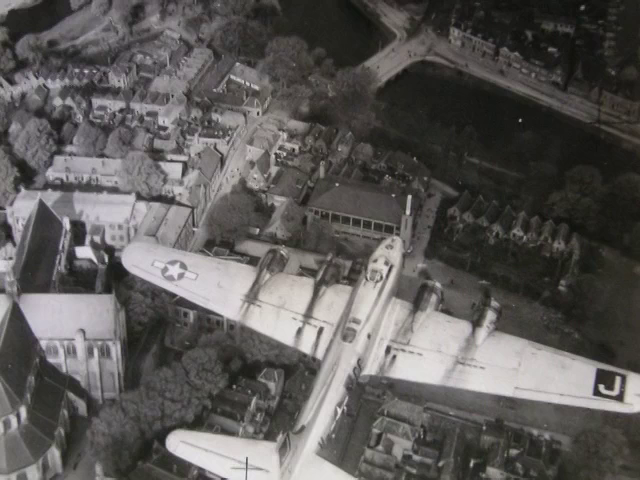 B-17 over Holland during Operation Chowhound
B-17 over Holland during Operation Chowhound
The US Army Air Force’s participation in this humanitarian effort was given the codename Operation Chowhound and consisted of six missions. John was part of the first, second and final missions. He said that they had to fly just below tree level and dropped the 45lb crates of 10 and 1 rations.
 Dutch man carrying crate of 10-1 rations dropped by U.S. during Operation Chowhound.
Dutch man carrying crate of 10-1 rations dropped by U.S. during Operation Chowhound.
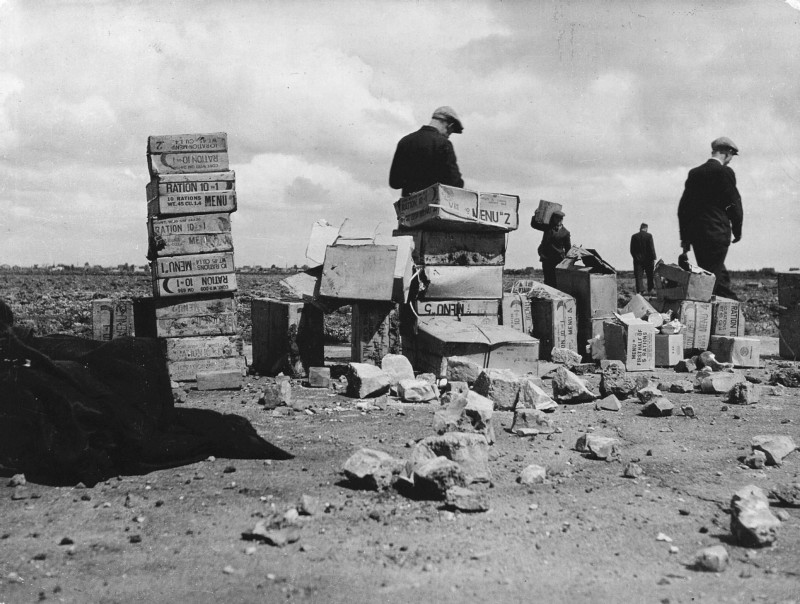 Crates of 10-1 rations dropped by U.S.
Crates of 10-1 rations dropped by U.S.
He saw people desperately waiting for the food and felt like he could “reach out and shake their hands”. All the while he could see the German anti-aircraft guns tracking his plane. He remembered thinking out loud that the Germans must not be firing on them because they needed the supplies as well. He agreed that they probably all realized that Germany’s defeat was inevitable.
John recalled seeing the words “Thank You Boys” spelled out with tulips in the field as they flew over.
 The Dutch people showed their appreciation for the American and British airmen by spelling out “Thank You Boys” in Tulips.
The Dutch people showed their appreciation for the American and British airmen by spelling out “Thank You Boys” in Tulips.
John commented that he initially thought the words were spelled out using white sheets. He soon realized that they were tulips.
John received a message from home about two weeks after this mission. His first child, a daughter, had been born on the same day as his final mission of the war.
B-17s Manned by John & Crew

She Dood It (339041 U). Note “U” under serial on tail, indicating that this B-17 is She Dood It.

May 17, 1945 collision of Satan’s Second Sister (338196 A – right) and Chapel in the Sky (339124 E – left) on a perimeter track of Station 153. Both planes were salvaged.
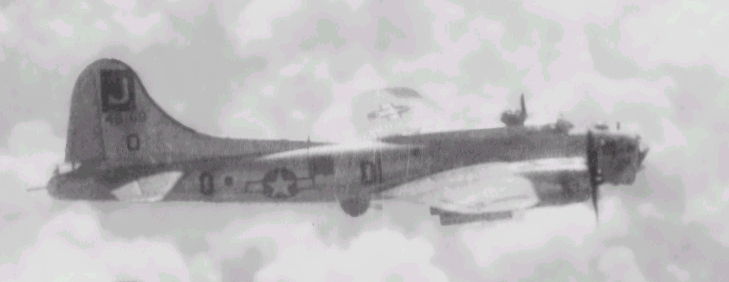
B-17 (48169 Q). No nickname was found for this B-17.
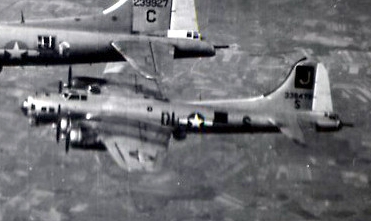 Hotter ‘N Hell (338478 S)
Hotter ‘N Hell (338478 S)
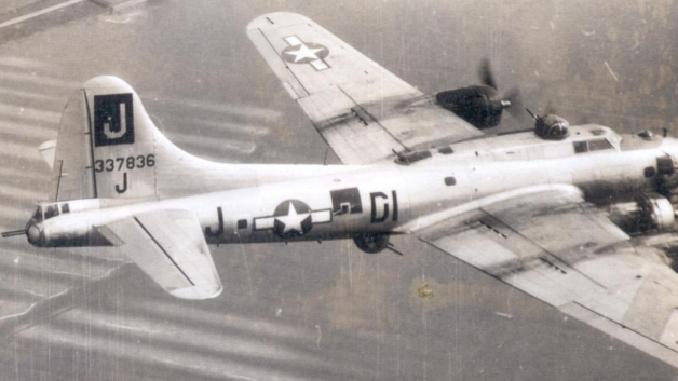
Merry Max (337836 J)
 Lady Faithful/They’ve Had It (339024 X) & Hotter ‘N Hell (338478 S)
Lady Faithful/They’ve Had It (339024 X) & Hotter ‘N Hell (338478 S)
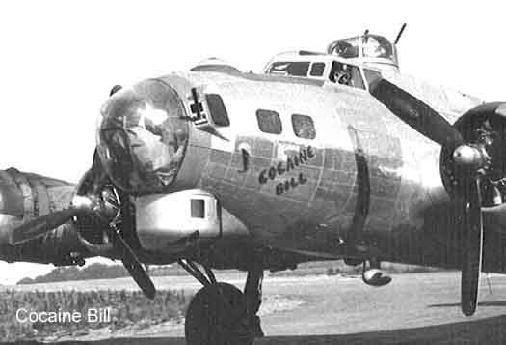
Cocaine Bill (46097 D)
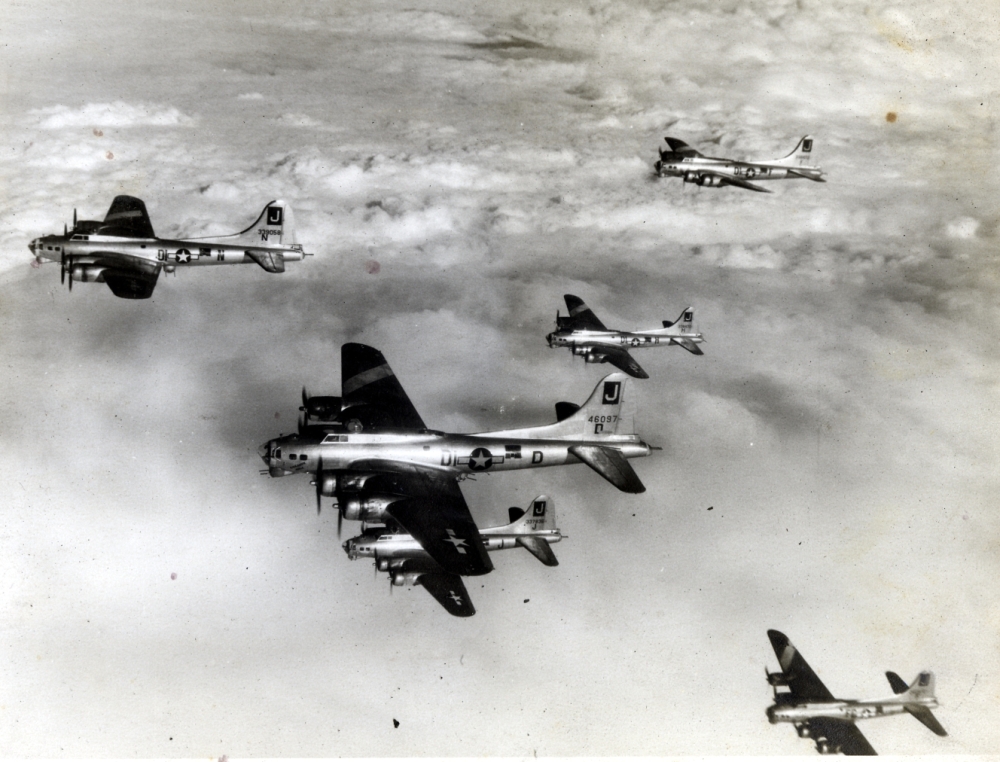
Cocaine Bill (46097 D) in foreground (center) and Merry Max (337836 J) just below her. This photo was not taken when John was on board Cocaine Bill or Merry Max as the plane at the far left, 339058 N, was only involved in missions prior to #275 which was the first of the 19 missions in which John participated.
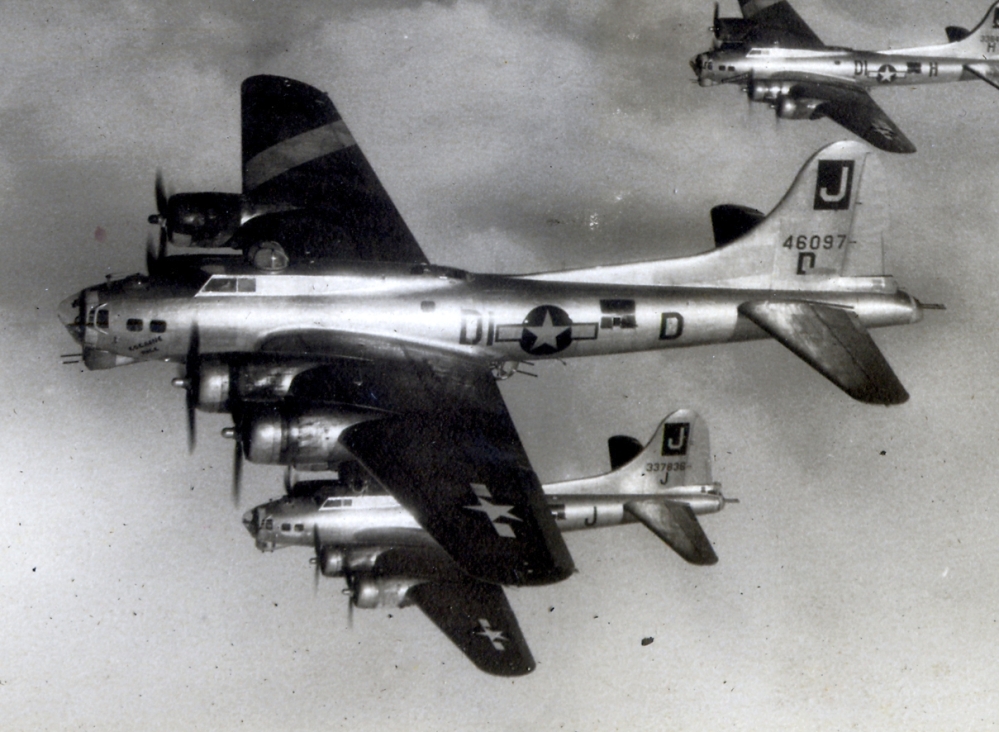
Closeup of Cocaine Bill (46097 D) in foreground (center) and Merry Max (337836 J) just below her.
Arnold M Singer Crew
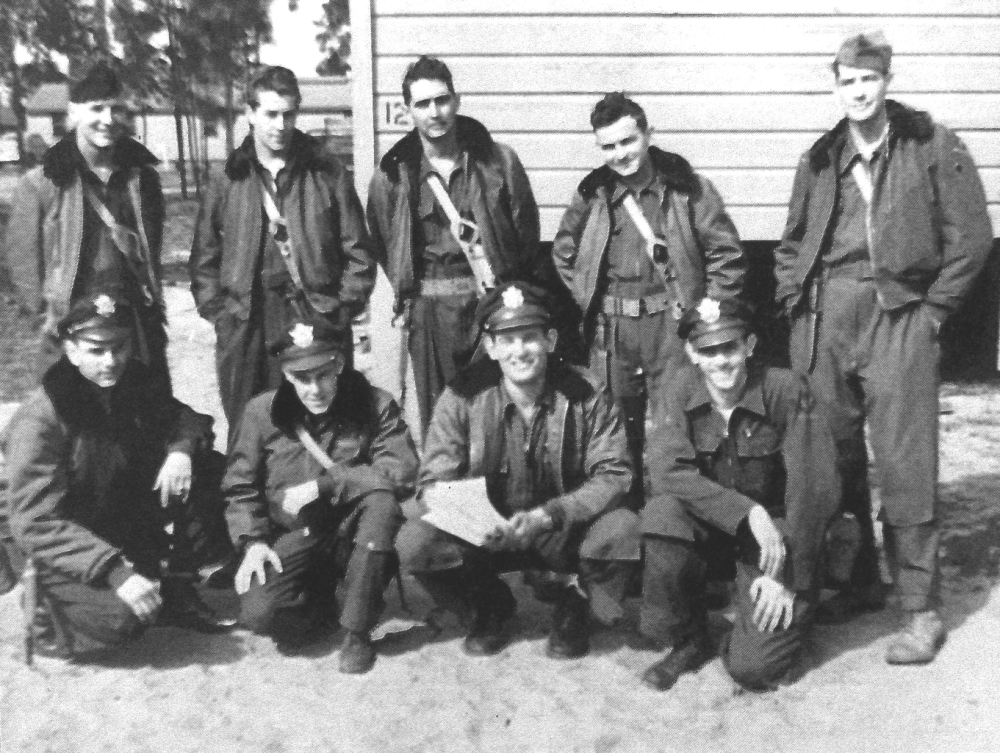
The Singer crew in front of barracks 1221 at RAF Framlingham – Back row (left to right): Albert G Barton (Tail Gunner), Donavon J O’Keefe (Waist Gunner), Burt Stevens Jr (Engineer / Top Turret), Samuel E Robertson (Ball Turret) and Theodore W Bessler (Radio Operator). Front Row (left to right): Arnold Morton Singer (Pilot), Robert W Smith (Co-pilot), Joseph W Hoffman (Navigator) and John Magill Jr (Bombardier/Togglier).
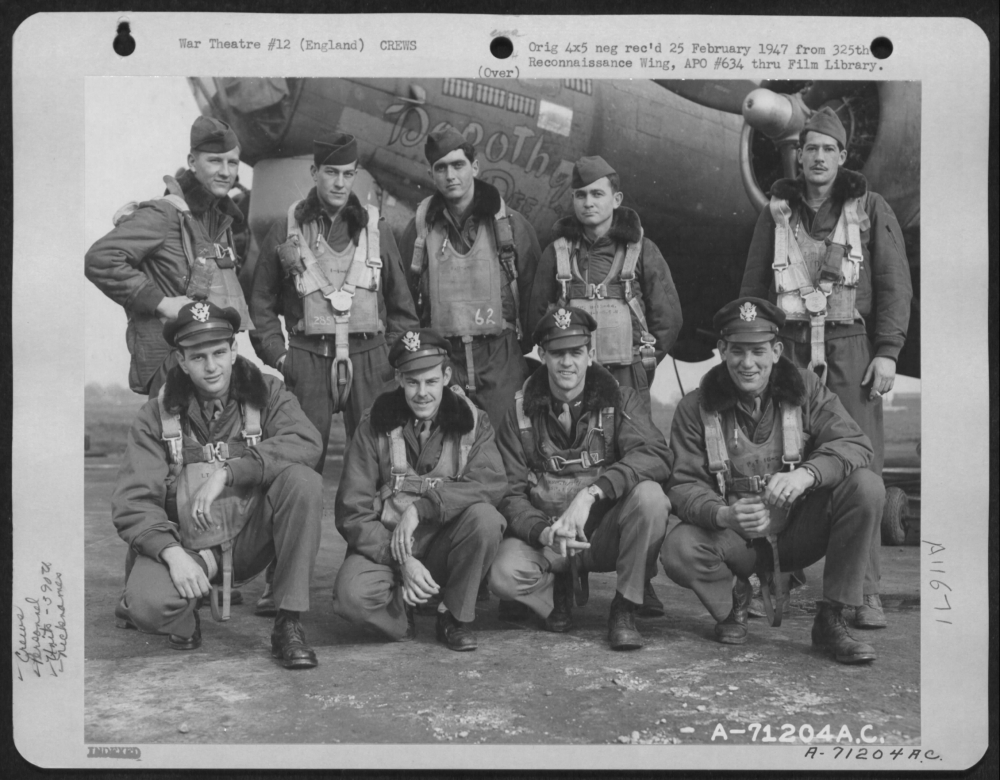 The Singer crew at RAF Framlingham – Back row (left to right): Albert G Barton (Tail Gunner), Donavon J O’Keefe (Waist Gunner), Burt Stevens Jr (Engineer / Top Turret), Samuel E Robertson (Ball Turret) and Theodore W Bessler (Radio Operator). Front Row (left to right): Arnold Morton Singer (Pilot), Robert W Smith (Co-pilot), John Magill Jr (Bombardier/Togglier) and Joseph W Hoffman (Navigator).
The Singer crew at RAF Framlingham – Back row (left to right): Albert G Barton (Tail Gunner), Donavon J O’Keefe (Waist Gunner), Burt Stevens Jr (Engineer / Top Turret), Samuel E Robertson (Ball Turret) and Theodore W Bessler (Radio Operator). Front Row (left to right): Arnold Morton Singer (Pilot), Robert W Smith (Co-pilot), John Magill Jr (Bombardier/Togglier) and Joseph W Hoffman (Navigator).
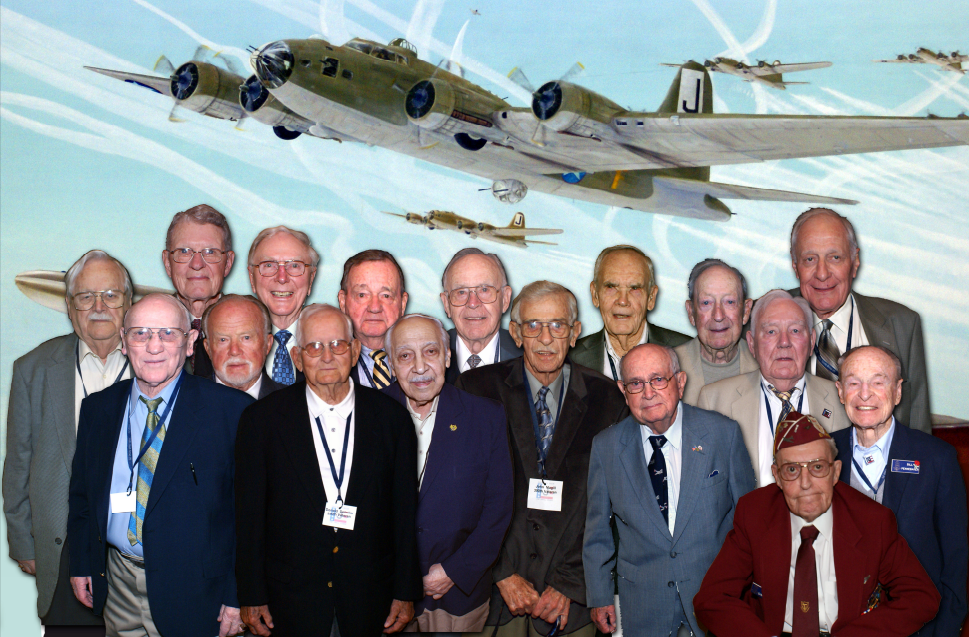 2012 390th Memorial Museum Reunion. Pictured left to Right: Robert Carr, Harold Kronnenberg, Ellis McClintick, William Ellett, Richard Bushong, Donald Detwiler, James Bowler, Nicholas Plackis, Richard Cowles, John Magill Jr, Tom Rountree, Samuel Robertson, John Keema, Vincent Evans, Jake Simonitsch, Bill MacVicar, William Pennebaker.
2012 390th Memorial Museum Reunion. Pictured left to Right: Robert Carr, Harold Kronnenberg, Ellis McClintick, William Ellett, Richard Bushong, Donald Detwiler, James Bowler, Nicholas Plackis, Richard Cowles, John Magill Jr, Tom Rountree, Samuel Robertson, John Keema, Vincent Evans, Jake Simonitsch, Bill MacVicar, William Pennebaker.
 John returning home from Honor Flight at San Diego International Airport on May 1, 2016. Source: San Diego Union Tribune.
John returning home from Honor Flight at San Diego International Airport on May 1, 2016. Source: San Diego Union Tribune.
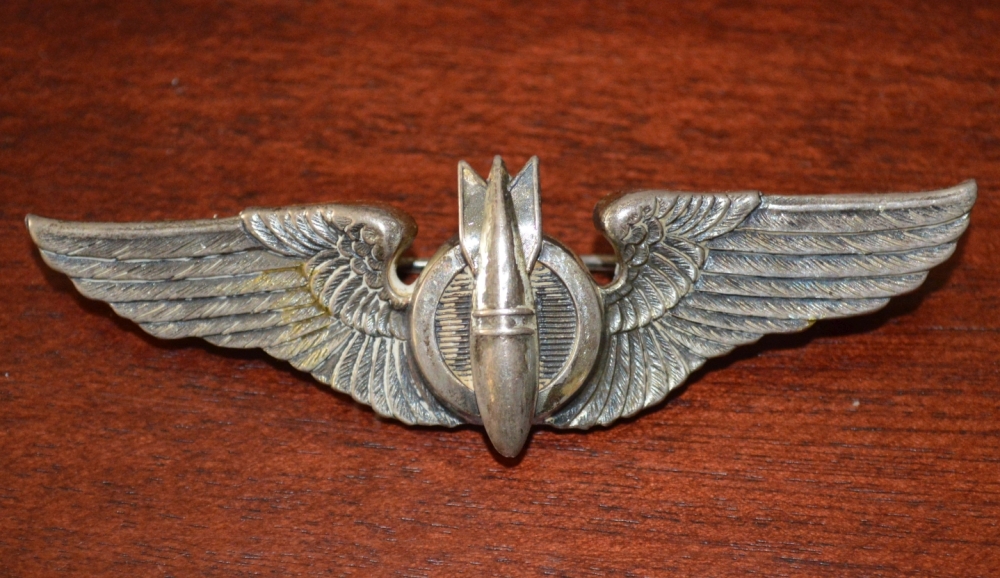 John’s Bombardier Wings. He received these after graduating from Bombardier School.
John’s Bombardier Wings. He received these after graduating from Bombardier School.
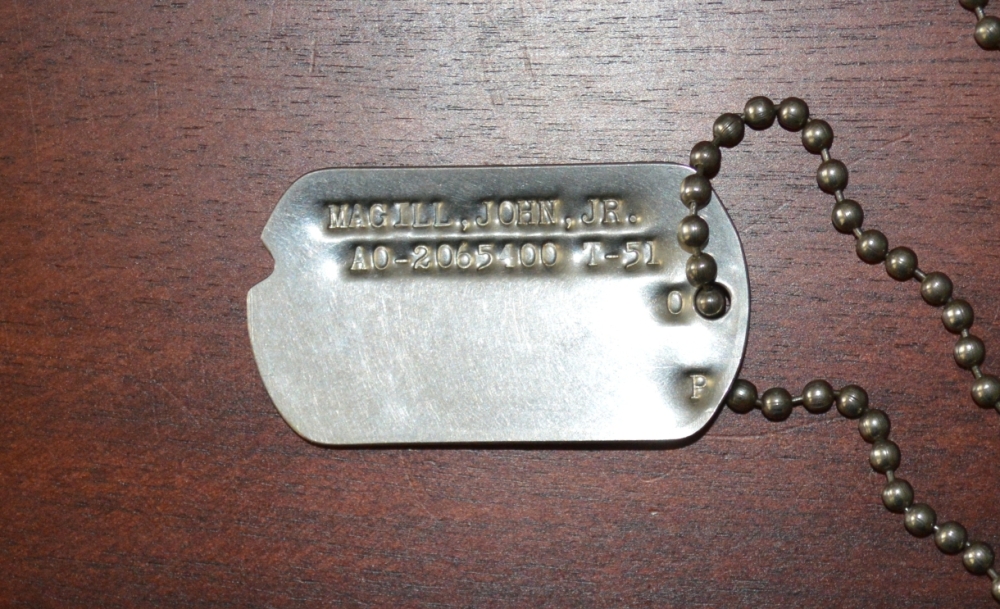 John’s military ID tag. He carried this with him on all his missions.
John’s military ID tag. He carried this with him on all his missions.
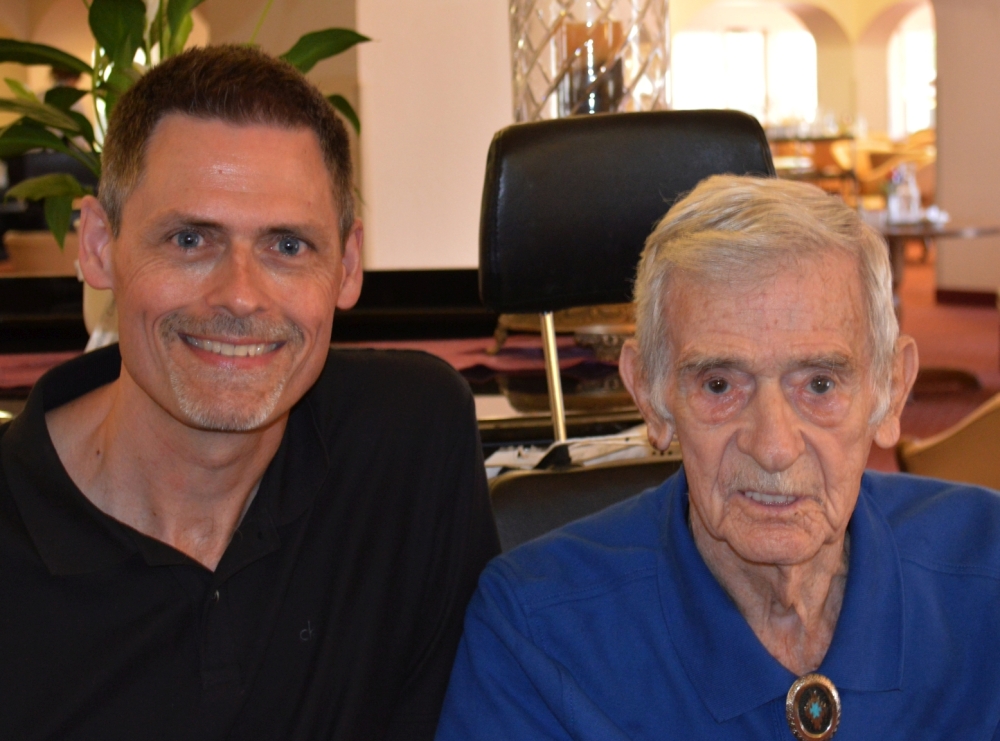
John Magill and Brent Spencer – Jul 9, 2016.
John said that, like many other WWII airmen, his most memorable moment was his first mission. Prior to his first, John recalled asking several crew members who had already had this experience what it was like. All they said was “you’ll see”. John soon found out what they all meant. After returning from his first, John distinctly recalled not wanting to go on any more, but, of course, having no choice in the matter.
John is, and rightfully so, very proud of his service to our country. On January 8, 1981 he retired from 38 years, 11 months and 15 days of military service. He attained the rank of Lieutenant Colonel.
John’s favorite sayings are “I have a lot of stories, and some of them are true” and “I have two speeds; one’s slow and the other is stop.”
Medals and Honors: Air Medal with 1 Oak Leaf Cluster and the European–African–Middle East (EAME) Campaign Ribbon.

Where can I find the original information on some of the pictures. Specifically the ones where Merry Max is in the picture. My grandfather was on the original crew for that plane as it was named for the pilot’s wife. It is possible that he is in the pictures of the Merry Max that are posted on this site. I am mostly interested in the dates those photo’s were taken if it is known. Thanks,
Allan
LikeLike
Allan, if you haven’t already, look into the 390th Memorial Museum in Tucson, AZ. The website is 390th.org, although your best bet might be to call them directly.
LikeLiked by 1 person
I believe the squadron H fortress in the background with Cocaine Bill is 338470. 338456 is unnamed so is 338472. These are the only three that have overlapped missions with both of the other planes. I think I can make out the serial number and “CK” in the black banner under the cockpit.
LikeLiked by 1 person
Philip, I agree that it’s 338470.
LikeLike